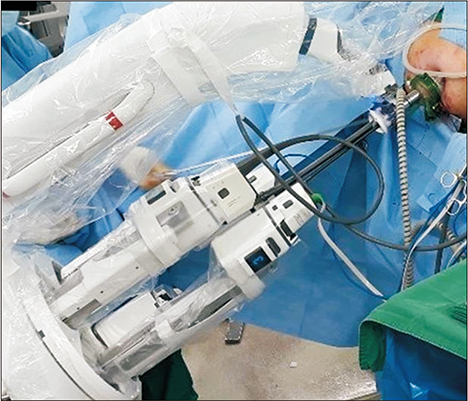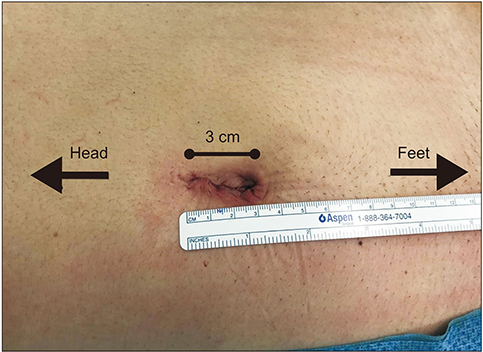Investig Clin Urol.
2019 Jul;60(4):326-330. 10.4111/icu.2019.60.4.326.
Pure single-site robot-assisted pyeloplasty with the da Vinci SP surgical system: Initial experience
- Affiliations
-
- 1Department of Urology and Urological Science Institute, Yonsei University College of Medicine, Seoul, Korea. sindakjang@yuhs.ac
- 2Department of Urology, Konyang University College of Medicine, Daejeon, Korea.
- KMID: 2450551
- DOI: http://doi.org/10.4111/icu.2019.60.4.326
Abstract
- PURPOSE
Laparoendoscopic single-site surgery (LESS) reduces the limited invasiveness of conventional laparoscopy while providing superior cosmetic results. However, LESS remains a challenging surgical technique, even in robotic surgery, primarily due to the lack of triangulation and limited instrument movement. The da Vinci SP surgical system (Intuitive Surgical) was recently introduced to overcome these limitations. We describe our initial experience with pure single-site robot-assisted pyeloplasty (RAP) for ureteropelvic junction obstruction (UPJO) using the da Vinci SP surgical system.
MATERIALS AND METHODS
Three consecutive patients who were diagnosed with UPJO underwent RAP with the da Vinci SP surgical system from December 2018 to February 2019 at our institution. The surgical technique involved reproducing the steps of multi-port RAP. A 30-mm umbilical incision was made and the GelPOINT was inserted. The multichannel robotic port and the assistant's port were placed through the GelSeal cap. In all patients, Anderson-Hynes dismembered pyeloplasty was performed. The ureteral double J stent was inserted antegrade, and the drain was not placed.
RESULTS
The procedures were successfully completed using a pure single-site approach. There was no need for additional port placement or conversion to laparoscopic or open surgery. Total operative time in the three patients was 139, 180, and 213 minutes, respectively. No intraoperative complications occurred, and blood loss was minimal. The postoperative course of all patients was uneventful with no complications greater than Clavien-Dindo grade I surgical complications.
CONCLUSIONS
Pure single-site RAP using the da Vinci SP surgical system is feasible and safe.
MeSH Terms
Figure
Reference
-
1. Gettman MT, Box G, Averch T, Cadeddu JA, Cherullo E, Clayman RV, et al. Consensus statement on natural orifice transluminal endoscopic surgery and single-incision laparoscopic surgery: heralding a new era in urology? Eur Urol. 2008; 53:1117–1120.
Article2. Box G, Averch T, Cadeddu J, Cherullo E, Clayman R, Desai M, et al. Urologic NOTES Working Group. Nomenclature of natural orifice translumenal endoscopic surgery (NOTES) and laparoendoscopic single-site surgery (LESS) procedures in urology. J Endourol. 2008; 22:2575–2581.
Article3. Autorino R, Cadeddu JA, Desai MM, Gettman M, Gill IS, Kavoussi LR, et al. Laparoendoscopic single-site and natural orifice transluminal endoscopic surgery in urology: a critical analysis of the literature. Eur Urol. 2011; 59:26–45.
Article4. Kaouk JH, Goel RK, Haber GP, Crouzet S, Stein RJ. Robotic single-port transumbilical surgery in humans: initial report. BJU Int. 2009; 103:366–369.
Article5. Han WK, Kim DS, Jeon HG, Jeong W, Oh CK, Choi KH, et al. Robot-assisted laparoendoscopic single-site surgery: partial nephrectomy for renal malignancy. Urology. 2011; 77:612–616.
Article6. Olweny EO, Park SK, Tan YK, Gurbuz C, Cadeddu JA, Best SL. Perioperative comparison of robotic assisted laparoendoscopic single-site (LESS) pyeloplasty versus conventional LESS pyeloplasty. Eur Urol. 2012; 61:410–414.
Article7. Best SL, Donnally C, Mir SA, Tracy CR, Raman JD, Cadeddu JA. Complications during the initial experience with laparoendoscopic single-site pyeloplasty. BJU Int. 2011; 108:1326–1329.
Article8. Autorino R, Kaouk JH, Stolzenburg JU, Gill IS, Mottrie A, Tewari A, et al. Current status and future directions of robotic single-site surgery: a systematic review. Eur Urol. 2013; 63:266–280.
Article9. Seideman CA, Tan YK, Faddegon S, Park SK, Best SL, Cadeddu JA, et al. Robot-assisted laparoendoscopic single-site pyeloplasty: technique using the da Vinci Si robotic platform. J Endourol. 2012; 26:971–974.
Article10. Kaouk J, Garisto J, Eltemamy M, Bertolo R. Pure single-site robot-assisted partial nephrectomy using the SP surgical system: initial clinical experience. Urology. 2019; 124:282–285.
Article11. Kaouk J, Bertolo R, Eltemamy M, Garisto J. Single-port robot-assisted radical prostatectomy: first clinical experience using the SP surgical system. Urology. 2019; 124:309.
Article12. Dindo D, Demartines N, Clavien PA. Classification of surgical complications: a new proposal with evaluation in a cohort of 6336 patients and results of a survey. Ann Surg. 2004; 240:205–213.13. Sorokin I, Cadeddu JA. Robotic laparoendoscopic single site: pyeloplasty and nephrectomy chapter. J Endourol. 2018; 32:S88–S92.
Article14. Bertolo R, Garisto J, Gettman M, Kaouk J. Novel system for robotic single-port surgery: feasibility and state of the art in urology. Eur Urol Focus. 2018; 4:669–673.
Article
- Full Text Links
- Actions
-
Cited
- CITED
-
- Close
- Share
- Similar articles
-
- Single-port robot-assisted prosthetic breast reconstruction with the da Vinci SP Surgical System: first clinical report
- Initial Clinical Experience of Pure Single-Incision Robotic Right Hemicolectomy with da Vinci SP Platform
- Comparison of intraoperative and short-term postoperative outcomes between robot-assisted laparoscopic multi-port pyeloplasty using the da Vinci Si system and single-port pyeloplasty using the da Vinci SP system in children
- Robot-assisted laparoendoscopic single-site upper urinary tract surgery with da Vinci Xi surgical system: Initial experience
- The First Korean Experience of Telemanipulative Robot-Assisted Laparoscopic Cholecystectomy Using the da Vinci System




